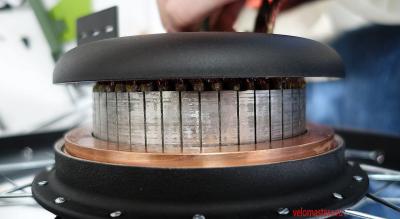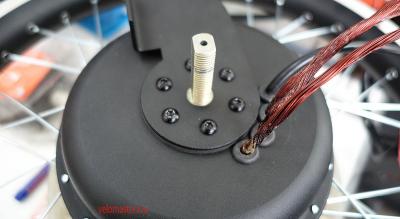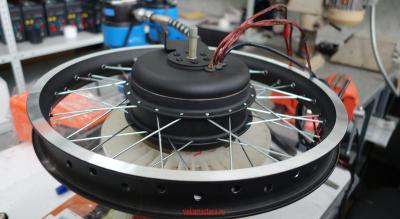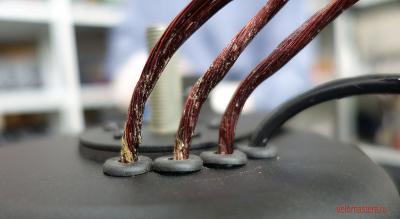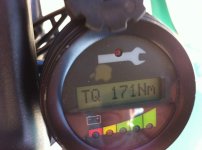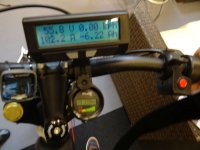You are using an out of date browser. It may not display this or other websites correctly.
You should upgrade or use an alternative browser.
You should upgrade or use an alternative browser.
Asynchronous motors - is induction the new future?
- Thread starter Allex
- Start date
Doctorbass
100 GW
ridethelightning said:wow!
this really cool. exciting!
look like a mini wider cro lol.. nice project!
Doc
Artur
100 kW
- Joined
- Jul 3, 2014
- Messages
- 1,117
macribs said:Is there any estimates on when these motors will go into production?
Think those 20kw motors be ideal for mid drives?
Great subtitles to english!
I think not sooner then next year. One thing is to make working prototype, and another thing is to mass produce a motor.
E-Chopper
10 W
Hello
From the first time i getting interesting in EV -Technology i´m woundering about why they only use Permanent Magnetic Motors for HUB-Motors .
Now i read this Post !! i hope this Motor work well !! So we dont need Neodym Magnet "then its a real Green Technology"
In Germany there is a Factory who rebuild Gasengine-Cars to full Electric powered Cars .
They use the good old "Nikola Tesla" Asynchron-Motors for there Engine´s
The Factory Telsa-Motors also use Inductionmotors .
https://www.teslamotors.com/blog/induction-versus-dc-brushless-motors
So in my opinion i hope it is a short way to "mass-production"
Greeting´s
Martin
From the first time i getting interesting in EV -Technology i´m woundering about why they only use Permanent Magnetic Motors for HUB-Motors .
Now i read this Post !! i hope this Motor work well !! So we dont need Neodym Magnet "then its a real Green Technology"
In Germany there is a Factory who rebuild Gasengine-Cars to full Electric powered Cars .
They use the good old "Nikola Tesla" Asynchron-Motors for there Engine´s
The Factory Telsa-Motors also use Inductionmotors .
https://www.teslamotors.com/blog/induction-versus-dc-brushless-motors
So in my opinion i hope it is a short way to "mass-production"
Greeting´s
Martin
0:55 ? = kganpaza said:Some "olds" (as opposed to news, video was published about a week ago).
[youtube]U8NRLRCftZg[/youtube]
I took half of hour to add English subtitles.
You must click on the "Subtitles" button to see them.
E-Chopper said:The Factory Telsa-Motors also use Inductionmotors .
https://www.teslamotors.com/blog/induction-versus-dc-brushless-motors
It seems that only the Tesla Roadster has an induction motor, instead the Model S has a DC brushless from what I know.
major
10 kW
bigbore said:E-Chopper said:The Factory Telsa-Motors also use Inductionmotors .
https://www.teslamotors.com/blog/induction-versus-dc-brushless-motors
It seems that only the Tesla Roadster has an induction motor, instead the Model S has a DC brushless from what I know.
You might want to check your facts. Tesla Model S uses induction motor drives. All steel and copper rotors.
anpaza
10 W
- Joined
- Dec 7, 2010
- Messages
- 69
At 14-17 April, in Monaco, the large asynchronous hub motor (the predcessor of Kolobok) will be demonstrated at the Top Marques exhibition. Who lives close to Monaco may give it a try 
Currently it's mounted into a ElMoto frame, with the Curtis-1232SE controller (48V, 350A max phase current). The max battery current was about 254A, battery voltage dropped to around 41V with this current. So, the max power consumption seen as of today with this motor was about 10kW.
[youtube]pVt4T9PJBP8[/youtube]
Currently it's mounted into a ElMoto frame, with the Curtis-1232SE controller (48V, 350A max phase current). The max battery current was about 254A, battery voltage dropped to around 41V with this current. So, the max power consumption seen as of today with this motor was about 10kW.
[youtube]pVt4T9PJBP8[/youtube]
anpaza said:At 14-17 April, in Monaco, the large asynchronous hub motor (the predcessor of Kolobok) will be demonstrated at the Top Marques exhibition. Who lives close to Monaco may give it a try
Currently it's mounted into a ElMoto frame, with the Curtis-1232SE controller (48V, 350A max phase current). The max battery current was about 254A, battery voltage dropped to around 41V with this current. So, the max power consumption seen as of today with this motor was about 10kW.
[youtube]pVt4T9PJBP8[/youtube]
I will be there! Look forward to discover it
Allex
100 MW
Looks like Stealth representative liked the motor and will probably test it on their frames, I think you can see John in the blue shirt in the end.
[youtube]CCRb3Af1aDI[/youtube]
[youtube]CCRb3Af1aDI[/youtube]
sn0wchyld
100 kW
link to kickstarter?
parabellum
1 MW
https://www.kickstarter.com/projects/700506444/e-bike-kolobok?ref=discoverysn0wchyld said:link to kickstarter?
Rapidement
100 µW
- Joined
- Oct 6, 2016
- Messages
- 7
[youtube]https://www.youtube.com/watch?v=0KKKH_abeic[/youtube]
Heat Distribution seems as if it would be better for this motor construct.
I am determined to try one out.
Does anyone know anything about a release date for it?
Heat Distribution seems as if it would be better for this motor construct.
I am determined to try one out.
Does anyone know anything about a release date for it?
Nice to see it has been developed further 
8,5kg would be great!!!, but it looks like there is much more iron and copper used..
I wonder if those induction motors (it should work like a cage rotor) have any drag?
Without permanent magents there should be virtually no drag, but this also would mean the motor won't induce a voltage by itself and a different controller is required for making regen possible (i think 4Q controllers should do it).
8,5kg would be great!!!, but it looks like there is much more iron and copper used..
I wonder if those induction motors (it should work like a cage rotor) have any drag?
Without permanent magents there should be virtually no drag, but this also would mean the motor won't induce a voltage by itself and a different controller is required for making regen possible (i think 4Q controllers should do it).
Not everything is infinitely scale-able, electric motors among those items.
As others have pointed out, induction motors create heat in the rotor as the bus bar conducts the induced power. The smaller the rotor is, the bigger the heat dissipation issue becomes and its not at a proportional level.
Likewise as BLDC systems get large enough they have their own issues where induction becomes an advantage. Among today's offerings there seems to be a point around 2000-400 watts where AC becomes better than DC from a size-performance factor.
It's not likely we'll see many BLDC mass-production cars nor many AC mass-production eBikes, at least in the next 5 years.
As others have pointed out, induction motors create heat in the rotor as the bus bar conducts the induced power. The smaller the rotor is, the bigger the heat dissipation issue becomes and its not at a proportional level.
Likewise as BLDC systems get large enough they have their own issues where induction becomes an advantage. Among today's offerings there seems to be a point around 2000-400 watts where AC becomes better than DC from a size-performance factor.
It's not likely we'll see many BLDC mass-production cars nor many AC mass-production eBikes, at least in the next 5 years.
Ianhill
1 MW
- Joined
- Sep 25, 2015
- Messages
- 2,871
https://www.tesla.com/en_GB/blog/induction-versus-dc-brushless-motors
Here's a nice little read on the argument, Ideally the ultimate motor break through would be a magnet that can be electrically increased or decreased in flux strength but still retain a very strong magnetic flux under no volt condition's this could give high efficiency at start up torque and at full speed when torque lags and efficiency drops the induction feed back loop could boost torque and efficiency at the same time. Theres clearly room for improvement but where will it come from.
Edit
You could achieve this effect with two ac motors one Induction the other magent, bolted together and the controller could monitor both motors and fire the magnet up for start torque and bring in the Induction at a higher rpm so efficiency is boosted and speed capabilitys, giving my secrets away now.
Here's a nice little read on the argument, Ideally the ultimate motor break through would be a magnet that can be electrically increased or decreased in flux strength but still retain a very strong magnetic flux under no volt condition's this could give high efficiency at start up torque and at full speed when torque lags and efficiency drops the induction feed back loop could boost torque and efficiency at the same time. Theres clearly room for improvement but where will it come from.
Edit
You could achieve this effect with two ac motors one Induction the other magent, bolted together and the controller could monitor both motors and fire the magnet up for start torque and bring in the Induction at a higher rpm so efficiency is boosted and speed capabilitys, giving my secrets away now.
liveforphysics
100 TW
Ianhill said:https://www.tesla.com/en_GB/blog/induction-versus-dc-brushless-motors
Here's a nice little read on the argument, Ideally the ultimate motor break through would be a magnet that can be electrically increased or decreased in flux strength but still retain a very strong magnetic flux under no volt condition's this could give high efficiency at start up torque and at full speed when torque lags and efficiency drops the induction feed back loop could boost torque and efficiency at the same time. Theres clearly room for improvement but where will it come from.
Edit
You could achieve this effect with two ac motors one Induction the other magent, bolted together and the controller could monitor both motors and fire the magnet up for start torque and bring in the Induction at a higher rpm so efficiency is boosted and speed capabilitys, giving my secrets away now.
Hybrid motors already exist that have just enough PM to enable cruising. Modern IPM motors are kinda replacing induction by getting the best of both worlds, with respect to sipping watts cruising at light loads, and using reluctance torque in the shape of the rotor iron around the magnets to deliver torque well beyond what the comparatively small magnets alone could offer.
Ianhill
1 MW
- Joined
- Sep 25, 2015
- Messages
- 2,871
liveforphysics said:Ianhill said:https://www.tesla.com/en_GB/blog/induction-versus-dc-brushless-motors
Here's a nice little read on the argument, Ideally the ultimate motor break through would be a magnet that can be electrically increased or decreased in flux strength but still retain a very strong magnetic flux under no volt condition's this could give high efficiency at start up torque and at full speed when torque lags and efficiency drops the induction feed back loop could boost torque and efficiency at the same time. Theres clearly room for improvement but where will it come from.
Edit
You could achieve this effect with two ac motors one Induction the other magent, bolted together and the controller could monitor both motors and fire the magnet up for start torque and bring in the Induction at a higher rpm so efficiency is boosted and speed capabilitys, giving my secrets away now.
Hybrid motors already exist that have just enough PM to enable cruising. Modern IPM motors are kinda replacing induction by getting the best of both worlds, with respect to sipping watts cruising at light loads, and using reluctance torque in the shape of the rotor iron around the magnets to deliver torque well beyond what the comparatively small magnets alone could offer.
When I read that response I realize im just a young pup wet behind the ears, I will have to research the designs used in these hybrids take some of it in if i can find the drawings to some, ive seen and worked fitting the supply's to a few inverter drives for wound rotors but mainly squirrel cage, I wonder if its as easy as a squirrel cage with added magnets.
Another good read
http://m.machinedesign.com/motorsdrives/motors-efficiency-permanent-magnet-reluctance-and-induction-motors-compared
And another
https://sme-group.com/sinchronous-technology-motors/
After reading these articles it seems the squirrel cage motor is not long for this world the synchronous reluctant motor will take its place, Its nearing magnet motors level of strength and much better heat managment with the rotor plus a much lower cost to manufacture than the PM motors.
And that leads us back to a hybrid because even the SR motors efficiency's can be boosted even further and i suppose demand for exotic motors in cars so a hybrid design called the permanent magnet assisted synchronous reluctance motor would be used or the PMASynRM for short
The PMAsynRm uses ferrite magnets rather than rare earth magnets so they can be made cheaper than today's exotic rare earth pmsm motors/ bldc and perform just as well.
learningrc
100 mW
- Joined
- Feb 27, 2015
- Messages
- 38
Ideally the ultimate motor break through would be a magnet that can be electrically increased or decreased in flux strength but still retain a very strong magnetic flux under no volt condition's this could give high efficiency at start up torque and at full speed when torque lags and efficiency drops the induction feed back loop could boost torque and efficiency at the same time.
An active research topic in academia is the design variable flux-intensifying machines. See this abstract, for example.
These are IPM machines that use magnets with low coercivity so they can be more easily demagnetized and remagnetized. I spoke with a professor at the U of Wisconsin recently and he said that they've been able to change the strength of magnets in a couple milliseconds while they are running. And when I say demagnetized, I don't necessarily mean completely demagnetized. They have the ability to lower the flux density to 75%, 50%, 25% or anywhere in between.
It should be noted that the goal of this type of motor is to increase efficiency, not to provide the highest torque density.
They are particularly useful for varying duty cycle loads and I know very early versions of them have been used in some washing machines. They are perfect for the type of load usually found in electric vehicles.


